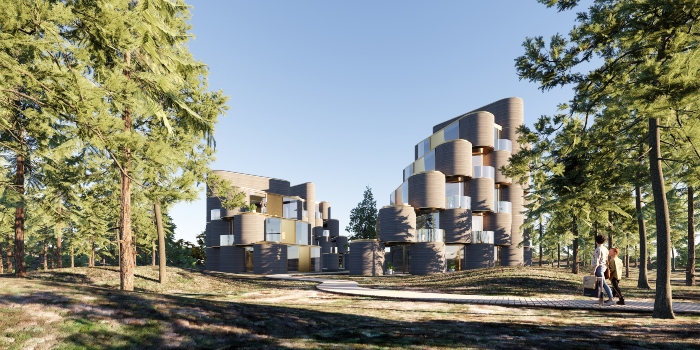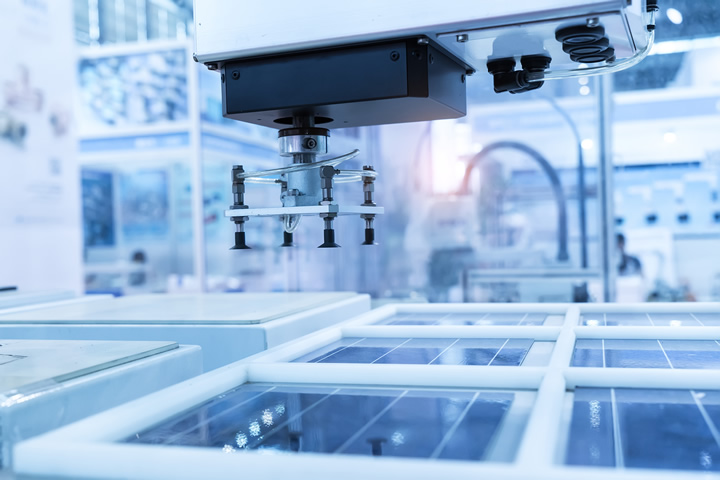3D concrete printing offers both opportunities and challenges
Written by: Lotte Krull
Publish Date: July 04, 2021


3D concrete printing sounds simple: you mix the concrete, pump it out through a print head, and build a wall layer by layer. How hard can it be? Ask one of the partners in the large-scale research project N3XTCON and you will find out. The project brings together players within Danish construction and Danish knowledge institutions to solve some of the biggest 3D concrete printing challenges. One of the challenges is in understanding the nature of concrete as a material, says Project Manager Thomas Juul Andersen, Danish Technological Institute:
“With current printing technology, we don’t know exactly when a print is about to collapse. We may have a good gut feeling, but we won’t know until the collapse actually occurs. Therefore, we typically have to print with a large safety margin. This can be achieved by printing more slowly or by changing the concrete mixture, for example.” Within the scope of the N3XTCON project therefore, the exploration of concrete as a material particularly focuses on how concrete flows and how fast it hardens. These are properties essential to successful 3D concrete printing.
“The concrete must be sufficiently liquid to be pumped through a nozzle, but at the same time we want it to find its shape immediately, so it doesn’t splatter all over the place. So the concrete has to be able to keep its shape immediately. This is something of a paradox: We need a material that’s both liquid and virtually solid at the same time,” says Thomas Juul Andersen.
Not too fast—not too slow
One of the parameters that can be adjusted to address these contradictory requirements is the speed at which the concrete is printed. Researchers at DTU are working on precisely this issue. In charge of research is Professor Henrik Stang, Deputy Director, DTU Civil Engineering. He explains:
“The optimal print is achieved using the right print speed. If you print too quickly, you run the risk of the concrete failing to harden before the next layer of concrete is laid on top—and then the construction becomes unstable, leading to potential deformation or even collapse. If you print too slowly, the concrete hardens too much, so that the layers don’t ‘merge’ together. Then you get construction joints all over the print which result in lower construction strength.”
To predict printing process and concrete behaviour, the researchers at DTU are therefore developing simulation tools—mathematical models which, among other things, define a series of material parameters for the concrete prior to printing, so it becomes possible to predict whether it is even feasible to print the planned construction and the way forward.
“Concrete is a material with many variables, and its properties can change from one mixture to the next, even though in principle you’re mixing the same ingredients in the same proportions. But factors such as temperature, the point at which you remove the pebbles from the gravel heap, and how long it takes from making the mixture to printing, all serve to create a great deal of uncertainty about how quickly you can print,” says Henrik Stang, who adds that the better the simulation tools, the better you can choose the right printing strategy. “The speed of the print also has an economic aspect because the faster you can print, the more economically viable it becomes as a construction technology,” says Henrik Stang.
Tool validation
The simulation tools are validated at Danish Technological Institute’s concrete laboratory which prints the concrete and tests whether the tools predict the behaviour of the concrete using a given printing strategy. One of the validation methods is digital image correlation.
“We document the entire printing process systematically with photos and monitor how the material behaves—how it flows and how it potentially deforms. In this way we can see whether the mathematical models correlate with what is happening in the real world,” says Thomas Juul Andersen.
The dream scenario is to be able to use the simulation tool while printing, says Henrik Stang:
“Ideally, we want to reach the point where we can perform construction calculations while printing. Then you can continuously use the calculations as a basis for controlling how printing should continue and whether to speed up or slow down.”
The road to sustainable concrete printing
An important part of N3XTCON is assessing the sustainability of concrete printing. Here, concrete as a material also plays an important role. Concrete is essentially stone that is bound together by cement and water. The production of cement emits large amounts of CO2, mainly due to the fact that it is a very energy-intensive production process. Denmark’s only cement producer—Aalborg Portland — is also participating in N3XTCON. In addition to testing the company’s cement types for concrete printing, Aalborg Portland is also there to learn, explains Jesper Sand Damtoft, Group Sustainability and R&D Director of Cementir Holding, Aalborg Portland’s parent company.
“Concrete printing is a technology we’ve started to receive inquiries about, and it’s clear that our customers expect guidance on its application,” says Jesper Sand Damtoft.
One of Aalborg Portland’s cement types that recently came on the market at the close of the year is FutureCEM. It is a newly developed cement type with a lower carbon footprint. In simple terms, FutureCEM has reduced the cement clinker content—the ingredient associated with the highest carbon emissions—and replaced that part of the clinkers with other materials. FutureCEM has the potential to reduce global carbon emissions from cement production by up to 30 per cent. Researchers in the N3XTCON project were therefore understandably excited when they tested FutureCEM in the concrete printing process. The results were very promising.
“FutureCEM has been tested with excellent results and naturally we’re very pleased. We were particularly interested in seeing how precisely this type of cement behaves because if you can use cement types with a lower carbon footprint, you’ll get a really good environmental profile out of 3D concrete-printed structures,” says Jesper Sand Damtoft.
Secret reinforcement solution
When the N3XTCON project began in 2019, the ambition was to develop 3D concrete printing, moving from printing non-reinforced structures in mortar to printing reinforced structures in concrete. The goal of 3D-printed concrete structures has been achieved, and surprisingly enough, the goal of 3D-printed reinforced concrete is reportedly close at hand.
Reinforcement increases the strength of a construction, and in traditional concrete construction, reinforcement is embedded in concrete either at the element factory or at the construction site. However, in 3D concrete printing, there are currently no robust industrialized solutions to the reinforcement issue. Several strategies have been tested—e.g. printing around a rebar structure. N3XTCON is continuing to work on developing more solutions, but it is still too early to reveal them, as they represent a potential trade secret for some of the partners in the project.
The project’s swan song
The final step in N3XTCON’s four-year project is to 3D concrete print two residential buildings designed by Henning Larsen Architects and BIG respectively—Bjarke Ingels Group (see article on page 16 about BIG’s project). The architects are participating in N3XTCON to explore, among other things, the design opportunities offered by 3D concrete printing. Whereas BIG plans to print offsite—i.e. not at the construction site, but instead using printed prefabricated elements transported to the construction site—Henning Larsen Architects plans to print in situ, i.e. at the construction site itself.
Both architectural companies see exciting opportunities in utilizing 3D concrete printing in construction. Troels Dam Madsen, Project Manager at Henning Larsen Architects, elaborates:
“3D concrete printing offers a completely different degree of freedom in concrete construction. Everything doesn’t have to have clear-cut angles, something current architecture is very much subject to because of the prefabricated concrete elements.”
Troels Dam Madsen is fascinated by the potential of 3D concrete printing to solve several problems simultaneously—among other things the effect of the printing on the building’s internal acoustics.
“Where a smooth concrete surface can cause acoustic problems, concrete printing allows you to create a completely different surface—e.g. with a lot of small folds, so that the sound is reflected more appropriately.”
Optimizing constructions
When there are no longer limits to the design process, it will also be cheaper to optimize the construction of the buildings, says Troels Dam Madsen:
“A lot of the manufactured concrete currently in use involves massively oversized structures where the aim is the greatest overall construction strength. With 3D concrete printing, we can stack material where a structure has to bear the load. This will save a lot of concrete in the construction process.”
Henrik Stang from DTU agrees:
“With 3D concrete printing, there’s huge potential to reduce concrete consumption in buildings, and among other things, the reason why it hasn’t yet been done is that it is much cheaper to cast large square blocks than it is to process optimize. Because with an optimization, you typically get some advanced geometries that are insanely expensive to make moulds for or to operationalize in an industrial production.”
Henrik Stang adds that concrete is an inexpensive material and therefore always interesting to use in construction—and soon with a reduced climate footprint.
“We have an obligation to ensure that the construction of future generations’ houses and infrastructure consumes significantly less resources than we have used thus far,” says Henrik Stang.
About the Author
This article is written by Lotte Krull
Read the original post here.


